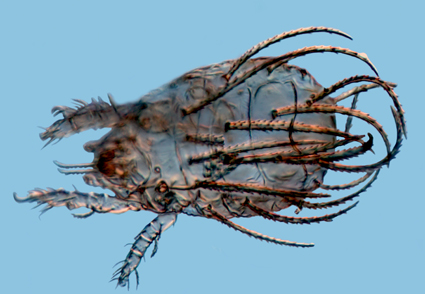Abstract
Morphological ontogeny of Oribatella similesuperbula Weigmann, 2001 based on specimens from Romania, is described and illustrated. The nymphs of this species are apopheredermous, i.e. they carry the exuvial scalps of previous instars away from the dorsal integument, using modified setal pair da. The prodorsal and most gastronotal setae of juveniles are long and barbed, except for medium sized h2 and minute h3 in the larva, and medium sized c1, p2 and p3 in the nymphs. The larva has 12 pairs of gastronotal setae, the nymphs have 15 pairs. In all juveniles, a humeral organ is present.
References
Balogh, J. (1943) Magyarország Páncélosatkái (Conspectus Oribateorum Hungariae). Matematikai és természettudományi közlemenyek, 39 (5), 1–202.
Balogh, J. & Mahunka, S. (1969) The scientific results of the Hungarian Soil Zoological expedition to South America. 11. Acari: oribatids from the material of the second expedition. II. Opuscula Zoologica, Budapest, 9 (1), 31–69.
Banks, N. (1895) On the Oribatoidea of the United States. Transactions of the American Entomological Society, 22, 1–16.
Behan-Pelletier, V.M. (2011) Oribatella (Acari, Oribatida, Oribatellidae) of eastern North America. Zootaxa, 2973 (1), 1–56.https://doi.org/10.11646/zootaxa.2973.1.1
Behan-Pelletier V.M. & Eamer B. (2010) The first sexually dimorphic species of Oribatella (Acari, Oribatida, Oribatellidae) and a review of sexual dimorphism in the Brachypylina. Zootaxa, 2332 (1), 1–20.https://doi.org/10.11646/zootaxa.2332.1.1
Behan-Pelletier, V.M. & Walter, D.E. (2012) Oribatella (Acari, Oribatida, Oribatellidae) of Western North America. Zootaxa, 3432 (1), 1–62.https://doi.org/10.11646/zootaxa.3432.1.1
Berlese, A. (1904) Acari nuovi. Manipulus II. Redia, 1 (1903), 258–280.
Berlese, A. (1910) Lista di nuove specie e nuove generi di Acari. Redia, 6, 242–271.
Berlese, A. (1916) Centuria terza di Acari nuovi. Redia, 12, 283–338.
Bernini, F. (1975) Notulae Oribatologicae XIII. La famiglia Oribatellidae (Acarida, Oribatei) nell’Arcipelago Toscano (Studi sulla Riserva Naturale dell’ Isola di Montecristo, X). Lavori dela Societa Italiana Biogeografica, New Series, 5, 429–504.https://doi.org/10.21426/B65110013
Călugăr, A. & Ivan, O. (2013) Diversity and distribution of the edaphic mites (Acari: Gamasina, Oribatida) in some forest plantations from the Central Moldavian Plateau. Scientific papers, Iasi, Agronomy Series, 56 (2), 97–103.
Grandjean, F. (1953a) Observations sur les oribates (27e série). Bulletin du Museum nationale d’Histoire Naturelle, 2e Série, 25, 469–476.
Grandjean, F. (1953b) Essai de classification des oribates (acariens). Bulletin de la Société. Zoologique de France, 78, 421–446.
Hammer, M. (1958) Investigations on the oribatid fauna of the Andes Mountains. I. The Argentine and Bolivia. Det Kongelige Danske Videnskabernes Selskab Biologiske Skrifter, 10, 1–129.
Koch, C.L. (1835) Deutschlands Crustaceen, Myriapoden und Arachniden. Heft 1–3. F. Pustet, Regensburg. [unknown pagination]
Michael, A.D. (1880) Further contribution to the knowledge of British Oribatidae. (Part I). Journal of the Royal Microscopical Society, 3, 32–43.https://doi.org/10.1111/j.1365-2818.1880.tb05649.x
Michael, A.D. (1898) Oribatidae. In: Schulze, F.E. (Ed.), Das Tierreich. Lief. 3 (Acarina). 8. Friedländer und Sohn, Berlin, pp. 1–93.https://doi.org/10.5962/bhl.title.69306
Nicolet, H. (1855) Histoire naturelle des Acariens qui se trouvent aux environs de Paris. Archives du Museum d’Histoire naturelle, Paris, 7, 381–482.https://doi.org/10.5962/bhl.title.66066
Norton, R.A. & Behan-Pelletier, V.M. (2009) Suborder Oribatida. In: Krantz, G.W. & Walter, D.E. (Eds.), A Manual of Acarology. 3rd Edition. Texas Tech University Press, Lubbock, Texas, pp. 430–564.
Norton, R.A. & Ermilov, S.G. (2014) Catalogue and historical overview of juvenile instars of oribatid mites (Acari: Oribatida). Zootaxa, 3833 (1), 1–132.https://doi.org/10.11646/zootaxa.3833.1.1
Seniczak, A., Seniczak, S. & Kaczmarek, S, (2015a) Morphology, distribution and ecology of Eupelops curtipilus and E. plicatus (Acari, Oribatida, Phenopelopidae). International Journal of Acarology, 41 (1), 77–95.https://doi.org/10.1080/01647954.2014.986523
Seniczak, A., Seniczak, S. & Kaczmarek, S. (2015b) Morphological and ecological differentiation of Eupelops and Propelops (Acari, Oribatida, Phenopelopidae). International Journal of Acarology, 41 (2), 41–69.https://doi.org/10.1080/01647954.2015.1010574
Seniczak, A., Seniczak, S., Kaczmarek, S., & Kowalski, J. (2014) Ontogeny of morphological traits in Phenopelopidae (Acari: Oribatida). International Journal of Acarology, 40 (8), 611–637.https://doi.org/10.1080/01647954.2014.975744
Seniczak, S. (1988) The morphology of juvenile stages of moss mites of the family Pelopidae Ewing (Acarida, Oribatida), II. Annales Zoologici, 41 (10), 383−393.
Seniczak, S., Ivan O., Marquardt, T. & Seniczak, A. (2020) Morphological ontogeny of Oribatella hungarica (Acari: Oribatida: Oribatellidae). Zootaxa, 4857 (1), 137–159. https://doi.org/10.11646/zootaxa.4857.1.8
Seniczak, S., Ivan O., Marquardt, T. & Seniczak, A. (2021) Morphological ontogeny of Oribatella reticulata (Acari: Oribatida: Oribatellidae). International Journal of Acarology, 47 (2), 126–136.https://doi.org/10.1080/01647954.2021.1879259
Seniczak, S. & Seniczak, A. (2013) Differentiation of external morphology of Oribatella Banks, 1895 (Acari: Oribatida: Oribatellidae), in light of the ontogeny of three species. Journal of Natural History, 47 (23–24), 1569–1611.
https://doi.org/10.1080/00222933.2012.763056
Seniczak, S., Seniczak, A. & Coulson, S.J. (2015c) Morphology, distribution and certain population parameters of the Arctic mite Oribatella arctica (Acari: Oribatida: Oribatellidae). International Journal of Acarology, 41 (5), 395–414.https://doi.org/10.1080/01647954.2015.1048727
Seniczak, S., Seniczak, A. & Coulson, S.J. (2017a) Morphological ontogeny, distribution, and descriptive population parameters of Hermannia reticulata (Acari: Oribatida: Hermanniidae), with comments on Crotonioidea. International Journal of Acarology, 43 (1), 52–72. https://doi.org/10.1080/01647954.2016.1229812.
Seniczak, S., Seniczak, A. & Coulson, S.J. (2017b) Morphological ontogeny and distribution of Hermannia scabra (Acari: Oribatida: Hermanniidae) in Svalbard and descriptive population parameters. Acarologia, 57 (4), 877–892.https://doi.org/10.24349/acarologia/20174214
Seniczak, S. & Słojewska, A. (1987) The morphology of juvenile stages of moss mites of the family Pelopidae (Acarida: Oribatida), I. Annales Zoologici, 40 (14), 521−533.
Subías, L.S. (2004 [update 2021]) Listado sistemático, sinonímico y biogeográfico de los Ácaros Oribátidos (Acariformes, Oribatida) del mundo (1758−2002). Graellsia, 60 (Número Extraordinario), 3−305. [15ª actualización, 527 pp.]https://doi.org/10.3989/graellsia.2004.v60.iextra.218
Thor, S. (1930) Beiträge zur Kenntnis der Invertebratenfauna von Svalbard. Skrifter om Svalbard og Ishavet, Oslo, 27, 1–156.
Weigmann, G. (2001) Contribution to the taxonomy of European Poronota I. Oribatella and Anachipteria. Spixiana, 24 (3), 235–240.


